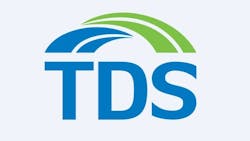Vicki Villacrez, TDS executive vice president, reported that the company continued to execute its priorities during the third quarter, highlighting progress UScellular has made and the sale of the company’s OneNeck IT solutions to US Signal, which closed in September. For the quarter, the company reported revenues of $1.2 billion, down 4.2% year over year.
“I am pleased with our third quarter performance,” said Villacrez. “Both business units are focused on meeting their financial objectives, resulting in UScellular increasing its profitability outlook for adjusted EBITDA and adjusted OIBDA, and TDS Telecom reaffirming its guidance.”
Serving fiber
Michelle Brukwicki, TDS Telecom’s senior vice president of finance and CFO, reported that as of the third quarter, 50% of the company’s service addresses are now served by fiber. The fiber footprint grew by 32,000 new marketable fiber addresses, a 9% year-over-year growth. Year-to-date, TDS Telecom has added 87,000 fiber addresses, with the goal of adding a total of 125,000 by year’s end. The company ended the quarter with a total of 886,000 fiber passings, with a long-term target of 1.2 million.
“Our fiber broadband strategy is continuing to deliver good results, contributing to a 2% increase in total operating revenue and a 21% increase in adjusted EBITDA for the quarter,” said Brukwicki. “We also grew total residential broadband connections 4% year-over-year. Our fiber strategy is extremely important. Fiber in our expansion and incumbent markets is providing growth, helping to overcome industry-wide competitive pressures facing our copper and cable markets.”
TDS Telecom ended the quarter with 1 Gbps speeds or higher offered to 74% of its footprint.
“We see increased demand for higher broadband speeds,” said Brukwicki, “with 79% of our customers taking 100 Mbps or greater, up from 75% a year ago. We continue to increase the availability of gig plus speeds, and customer take rates of these speeds are growing, with 20% of our customer base on 1-gig or higher at the end of the quarter.”
And while only about 20% of the base is on gig service, Brukwicki reported that about 40% of incoming customers are opting for 1 Gbps or higher speeds.
“That’s why you continue to see quarter-over-quarter, we keep moving our customers up that stack of speeds, and that’s also helping drive a bit of our ARPU increase,” she said. “And, of course, improving the customer experience and meeting the customer demand for broadband usage.”
Expanding residential service
TDS Telecom had 2,700 residential broadband net adds in the quarter, which contributed to 4% growth in residential broadband connections year-over-year.
“As we deliver new fiber service addresses, our teams are marketing and selling into those addresses,” said Brukwicki.
In the third quarter, TDS Telecom added 7,600 residential broadband net adds in its expansion markets but experienced net broadband losses in its cable markets. Brukwicki reported that the company remains focused on driving penetration in new expansion markets. To mitigate the impacts in the cable markets, TDS Telecom plans to promote gig speeds and strategically overbuild the networks with fiber in certain areas, as well as putting fiber in all new greenfield builds.
“We continued to see impacts from two discrete items that we also mentioned in the second quarter: First, we experienced additional ACP disconnects this quarter, 600 in ILEC and 500 in cable. Second, we had an additional 1,000 cable net losses this quarter due to the wildfire in Ruidoso, New Mexico, that occurred in June,” she said.
Average residential revenue per connection increased 5%, which Brukwicki attributed primarily to price increases.
“With increases in broadband connections and revenue per user, we saw 5% growth in residential revenues,” she said. “Specifically, expansion markets delivered $29 million of residential revenues in the quarter, compared to $20 million a year ago. As expected, commercial revenues decreased 4% in the quarter as we continue to decommission our CLEC markets. Lastly, wholesale revenues decreased 3% as customers migrate to lower-cost products.”
Operating revenues for the quarter were up 2%, with the growth in residential revenues being offset by the decline in commercial and wholesale revenues.
“As our fiber connections and revenues grow, coupled with a 4% decrease in cash expenses for the quarter, we are seeing nice growth in adjusted EBITDA, up 21%,” said Brukwicki. “Capital expenditures were $78 million in the quarter, down 55% from last year, as planned.”
For related articles, visit the Broadband Topic Center.
For more information on high-speed transmission systems and suppliers, visit the Lightwave Buyer’s Guide.
To stay abreast of fiber network deployments, subscribe to Lightwave’s Service Providers and Datacom/Data Center newsletters.
About the Author

Hayden Beeson
Hayden Beeson is a writer and editor with over seven years of experience in a variety of industries. Prior to joining Lightwave and Broadband Technology Report, he was the associate editor of Architectural SSL and LEDs Magazine.

